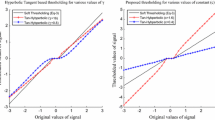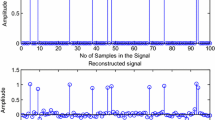Abstract
It has been shown that, magnetic resonance images (MRIs) with sparsity representation in a transformed domain, e.g. spatial finite-differences (FD), or discrete cosine transform (DCT), can be restored from undersampled k-space via applying current compressive sampling theory. The paper presents a model-based method for the restoration of MRIs. The reduced-order model, in which a full-system-response is projected onto a subspace of lower dimensionality, has been used to accelerate image reconstruction by reducing the size of the involved linear system. In this paper, the singular value threshold (SVT) technique is applied as a denoising scheme to reduce and select the model order of the inverse Fourier transform image, and to restore multi-slice breast MRIs that have been compressively sampled in k-space. The restored MRIs with SVT for denoising show reduced sampling errors compared to the direct MRI restoration methods via spatial FD, or DCT. Compressive sampling is a technique for finding sparse solutions to underdetermined linear systems. The sparsity that is implicit in MRIs is to explore the solution to MRI reconstruction after transformation from significantly undersampled k-space. The challenge, however, is that, since some incoherent artifacts result from the random undersampling, noise-like interference is added to the image with sparse representation. These recovery algorithms in the literature are not capable of fully removing the artifacts. It is necessary to introduce a denoising procedure to improve the quality of image recovery. This paper applies a singular value threshold algorithm to reduce the model order of image basis functions, which allows further improvement of the quality of image reconstruction with removal of noise artifacts. The principle of the denoising scheme is to reconstruct the sparse MRI matrices optimally with a lower rank via selecting smaller number of dominant singular values. The singular value threshold algorithm is performed by minimizing the nuclear norm of difference between the sampled image and the recovered image. It has been illustrated that this algorithm improves the ability of previous image reconstruction algorithms to remove noise artifacts while significantly improving the quality of MRI recovery.






Similar content being viewed by others
References
Lustig M, Donoho D, Pauly JM (2007) Sparse MRI: the application of compressed sensing for rapid MR imaging. Magn Reson Med 58(6):1182–1195
Ljunggren S (1983) A simple graphical representation of fourier-based imaging methods. J Magn Reson 54(2):338–343
Twieg D (1983) The k-trajectory formulation of the NMR imaging process with applications in analysis and synthesis of imaging methods. Med Phys 10(5):610–621
Tsaig Y, Donoho D (2006) Extensions of compressed sensing. Signal Process 86(3):533–548
Chralampidis D, Kasparis T, Georgiopoulos M (2001) Classification of noisy signals using fuzzy ARTMAP neural networks. IEEE Trans Neural Netw 12(5):1023–1036
Wichmann F, Braun D, Gegenfurtner K (2006) Phase noise and the classification of natural images. Vis Res 46(8–9):1520–1529
Wiener N (1949) Extrapolation, interpolation, and smoothing of stationary time series. Wiley, New York
Cai JF, Candès EJ, Shen Z (2010) A singular value thresholding algorithm for matrix completion’. SIAM J Optim 20(4):1956–1982
Lingala S, Yue H, DiBella E, Jacob M (2011) Accelerated dynamic MRI exploiting sparsity and low-rank structure: k-t SLR’. IEEE Trans Med Imaging 30(5):1042–1054
Recht B, Fazel M, Parrilo PA (2010) Guaranteed minimum-rank solutions of linear matrix equations via nuclear norm minimization. SIAM Rev 52(3):471–501
Osher S, Mao Y, Dong B, Yin W (2010) Fast linearized Bregman iteration for compressive sensing and sparse denoising. Commun Math Sci 8(1):93–111
Antoulas A (2005) Approximation of large-scale dynamical systems. SIAM, New York
Golub GH, Van Loan CF (1996) Matrix computations. The John Hopkins University Press, Baltimore, MD
Schneider MK, Willsky A (2001) Krylov subspace estimation. SIAM J Sci Comput 22(5):1840–1864
Bai Z (2002) Krylov subspace techniques for reduced-order modeling of large-scale dynamical systems. Appl Num Math 43(1–2):9–44
Rudin L, Osher S, Fatemi E (1992) Non-linear total variation noise removal algorithm. Phys D 60:259–268
Huynh-Thu Q, Ghanbari M (2008) Scope of validity of PSNR in image/video quality assessment. Electron Lett 44:800–801
Mu T, Nandi AK, Rangayyan RM (2007) Classification of breast masses via nonlinear transformation of features based on a kernel matrix. Med Biol Eng Comput 45(8):769–780
Sun F, Morris D, Babyn P (2009) The optimal linear transformation-based fMRI feature space analysis. Med Biol Eng Comput 47(11):1119–1129
Yin XX, Ng BW-H, Yang Q, Pitman A, Ramamohanarao K, Abbott D (2012) Anatomical landmark localization in breast dynamic contrast-enhanced MR imaging. Med Biol Eng Comput 50(1):91–101
Acknowledgments
The MRI datasets were afforded by Q. Yang, Apollo Medical Imaging Technology Pty. Ltd. North Melbourne, VIC 3051, Australia, and A. Pitman, Department of Anatomy and Cell Biology, The University of Melbourne and Sydney School of Medicine, The University of Notre Dame, Australia. This work was supported in part by the Australian Research Council (ARC) Discovery Project funding scheme—Project No. DP0988064. This project was also carried out under an Australian Research Council (ARC) Linkage Grant—LP0775463.
Author information
Authors and Affiliations
Corresponding author
Rights and permissions
About this article
Cite this article
Yin, X.X., Ng, B.WH., Ramamohanarao, K. et al. Exploiting sparsity and low-rank structure for the recovery of multi-slice breast MRIs with reduced sampling error. Med Biol Eng Comput 50, 991–1000 (2012). https://doi.org/10.1007/s11517-012-0920-x
Received:
Accepted:
Published:
Issue Date:
DOI: https://doi.org/10.1007/s11517-012-0920-x




